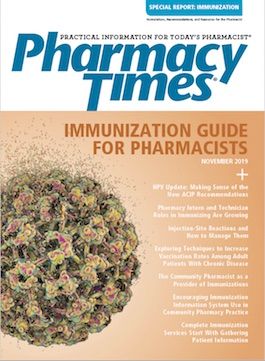Publication
Article
Supplements
Complete Immunization Services Start With Gathering Patient Information
Author(s):
Pharmacy team members have the amazing opportunity to help ensure that people and communities are protected with proper immunizations during influenza (flu) season and beyond, but they may struggle with identifying patients who may benefit because it can be difficult to gather information from patients.
One of the most common questions a pharmacist receives is, “Why did you become a pharmacist?” From my experience, most often the answer circles back to, “I wanted to help people.” Pharmacy team members have the amazing opportunity to help ensure that people and communities are protected with proper immunizations during influenza (flu) season and beyond, but they may struggle with identifying patients who may benefit because it can be difficult to gather information from patients. The quick solution to this problem is to remember that almost everyone needs vaccines. The long-term solution is to establish a routine, and stick to it, ensuring that vaccine administrations are properly documented and reported, thus providing vital information that patients and fellow health care professionals need to ensure all patients are properly vaccinated. Some tips on how to accomplish this are discussed below.
BE PROACTIVE! ASK EVERY PATIENT ABOUT THEIR IMMUNIZATION HISTORY, EVERY TIME
When a patient goes to any health care establishment, chances are that they hear the same set of questions at each visit, and their experience at the pharmacy should be no different. However, based on my own experience, when asking a patient about immunizations, doctors often stop at the flu shot. As a pharmacist, you have an opportunity to change that by asking each patient about their overall immunization health. Every time you see a patient it is important to ask, “Do you need any immunizations today?” Use motivational interviewing during these patient conversations to gather as much information as possible.
USE PATIENT PROFILE REVIEW AND IMMUNIZATION INFORMATION SYSTEMS
Pharmacists already review patient profiles when dispensing prescriptions; including an immunization review adds just a small step to the standard routine. Many patients do not know that pharmacy teams are able to access their records to identify which vaccines may be needed and so the pharmacist can use the patient encounter as a way to educate the patient.
A sample conversation starter could be, “Mrs Jones, while I am reviewing your medication profile, I can also quickly check the immunization registry to ensure that you [or your child, if the individual is picking up medication for their child] are/is up to date on the recommended vaccines. Can I do that for you now or would you prefer to wait until you get home?”
Listen to your patients: They can provide a lot of information during patient encounters, and taking the time to listen and to document immunization information in the patient profile is vital. Some patient encounter scenarios in the community pharmacy that can turn into opportunities to start con- versations about immunizations are outlined in the table.1 Remember to also include immunization conversations during comprehensive medication reviews or other medication therapy management services.1
Some additional tips to ensure that patients are up-to-date on immunizations include:
- Use HALO to gather information and make appropriate recommendations for adult patients (Health condition, Age, Lifestyle, and Occupation).2
- Check for contraindications, and be aware of incomplete histories. Patients may have received vaccines at other pharmacies, their primary care provider, etc.
- Empower your pharmacy technicians to identify vaccine-eligible patients using a simple strategy, such as a list of potentially vaccination-eligible medications. (Also see “Exploring Techniques to Increase Vaccination Rates Among Adult Patients With Chronic Disease” on page 16.)
- Access the patient’s vaccination status using the state’s immunization information system (IIS) if available. Many of these systems solve an information-gathering problem. They capture immunization information from health care providers, hospitals, pharmacies, etc, at the state and/or city level. The IIS consolidates these data points into 1 complete record and provides records to patients and authorized professionals.3 (Also see “Encouraging Immunization Information System Use in Community Pharmacy Practice” on page 20.)
- If other clinical dispensing tools are available that indicate which vaccines patients may be eligible for, take advantage of the opportunity to help as many patients as possible.
COMMUNICATE FOR PATIENT SAFETY AND PROTECTED HEALTH
Documenting information is critical, including information self-reported by the patient. Having complete patient information makes it easier to identify any immunization gaps that still exist, and sharing this information is vital to ensuring positive health outcomes for all patients. Some ways to accomplish this include the following:
- Notifying a patient’s primary care provider (via email or fax) that the patient received a vaccine
- Updating the state IIS or any other system-wide immunization reporting sites
By focusing on the “small picture” benefits of vaccines—1 patient at a time—pharmacists can successfully convey the impact of vaccines to help motivate patients, making a difference in their lives and in the overall health of the public.
REFERENCES
- Use simple strategies to identify patients who may need vaccines. Therapeutic Research Center website. pharmacytech.therapeuticresearch.com/Content/ Articles/PTL/2017/Jun/Use-Simple-Strategies-to-Identify-Patients-Who-May- Need-Vaccines. Published June 2017. Accessed September 9, 2019.
- Before you vaccinate adults, consider their “H-A-L-O”! Immunization Action Coalition website. immunize.org/catg.d/p3070.pdf. Published April 2018. Accessed September 12, 2019.
- Immunization Information Systems (IIS). CDC website. cdc.gov/vaccines/ programs/iis/index.html. Reviewed June 7, 2019. Accessed September 9, 2019.







